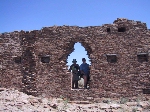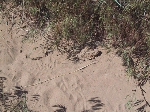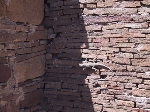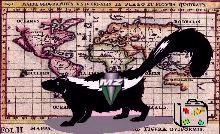



| Our hike to the Penasco Blanco ruins |
Click on the small pictures to see larger ones. |
| Just past the Pueblo del Arroyo ruins is a trail that leads past the Casa Chiquita ruins and, eventually, to the Penasco Blanco ruins. For this trail, too, you must obtain a permit at the Vistor's Center. The permit states when you plan to hike and how many people are going with you. The pink copy goes in your pocket and the white one on the dash of your car (even if you're not parking at the trailhead). Like I said, there are lots of rules in Chaco Culture. | ||||
| At any rate, the trail is easy hiking and along the way there are some wonderful petroglyphs (see Petroglyph Trail page), too. Penasco Blanco ("White Rock Point") sits high up on a hill and is partially built into the earth. From this vantage point you can see the Pueblo Bonito and Una Vida compounds back down the valley and can appreciate that each of the compounds was in a sight-line of the others even though they were spread across nearly eight miles. At the tops of the canyon, on rocky outcroppings, there were basins carved into the rock where fires would burn to signal messages to the other sites. Most of the rooms in the Penasco Blanco ruins have not been excavated and probably won't be. We saw lots of pieces of pottery laying around there. This particular site is unique in that it is laid out in an oval instead of the usual D-shape complex. | ||||
 |
 |
 |
 |
|
